Market
The Auction Market Is on Fire, But Fairs Are Still Flailing: 7 Takeaways From the 2022 Art Basel Market Report
Also, NFTs are definitely a thing.
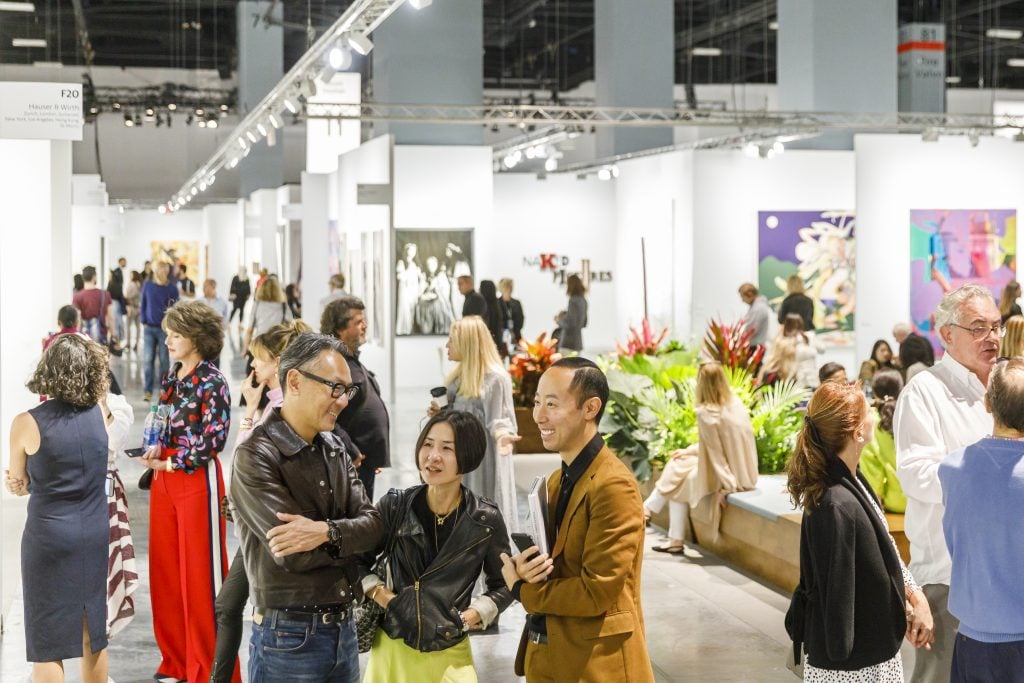
Also, NFTs are definitely a thing.

Eileen Kinsella

The findings of the latest UBS Art Basel Report, authored by cultural economist Clare McAndrew, will not come as a total surprise to industry observers who have watched art sales thrive over the past two years, defying predictions of a pandemic crash.
Even in the early days of the shutdown, starting in March 2020, private and online sales were robust by all accounts, as wealthy collectors confined to their homes splurged on new works. Auction houses not only thrived on private sales, but quickly pivoted in order to keep selling at least some seven- and eight-figure masterpieces at hybrid auctions streamed around the world, sometimes even jumping from one global arts hub to the next in the course of a single evening.
The 2022 edition of the report, released today (March 29), is the sixth in a series. The overarching theme is a “strong recovery of the market with return to live sales and events, while online sales continued to grow,” according to a report summary.
“The art market has demonstrated incredible resilience in 2021, with a strong uplift in aggregate sales, despite still operating under some very challenging conditions,” McAndrew said in a statement. “Dealers and auction houses successfully adjusted to a new two-tier system of online and offline sales and events.”
In fact, the market was “two-tiered” in more ways than one, with the new state of affairs also accelerating existing inequalities.
“We have seen that the break in schedules and shift to digital has done little to restructure the market’s hierarchies, and the high end began once again to pull away, with an even denser concentration of value on a small number of artists and businesses,” McAndrew continued.
Along with the usual breakdowns of auction sales, dealer sales, and leaders by region, McAndrew also takes a look at NFTs (non-fungible tokens) for the first time, and with the help of additional research, presents findings from a survey looking at the behaviors of high net worth (HNW) collectors (the survey was conducted by McAndrew and her company Arts Economics in connection with UBS Investor Watch). A startlingly high percentage of HNW collectors said they purchased NFTs—but the average value was relatively modest.
Here are seven key findings from the report.
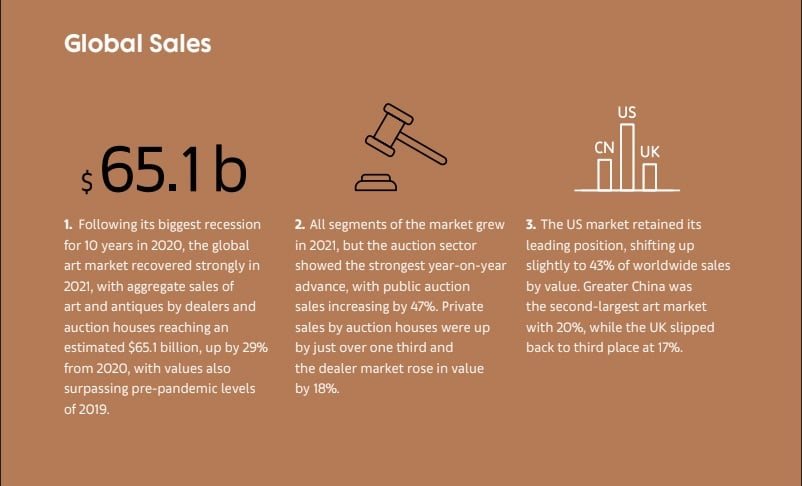
Image courtesy Arts Economics and UBS
Following the largest drop in sales in ten years in 2020, the global art market bounced back in 2021, with aggregate sales of art and antiques up 29 percent to approximately $65.1 billion, surpassing pre-pandemic levels.
The U.S. market maintained its leading position and was up slightly on the basis of value of worldwide sales, accounting for 43 percent. The Chinese market was the second largest with 20 percent of worldwide sales by value. Meanwhile the U.K. slipped back to third place with 17 percent of worldwide sales by value.
The rebound in U.S. sales in 2021 was particularly robust with sales rising by 33 percent to just over $28 billion. Despite losing ground to China, where sales rose 35 percent to $13.4 billion, the U.K. market also increased after two years of declines, to $11.3 billion, a jump of 14 percent.
France also saw a strong uptick in 2021, with sales up 30 percent. By value, the French increase was a hefty 50 percent with a reported total of $4.7 billion—the highest in ten years for France.

Image courtesy Arts Economics and UBSDealer Figures
The picture was also brighter for dealers. After a decline of 20 percent in 2020, aggregate sales reached an estimated $34.7 billion in 2021, increasing 18 percent year-on-year. Still, they remained below the level of 2019.
Across all dealers, a majority (61 percent) reported an increase in sales values year-on-year from 2020, while 13 percent were stable and a little over a quarter (26 percent) experienced a decline.
Of note: The highest rise in values year-on-year was in the segment of high-end dealers, those with sales between $5 million and $10 million (35 percent), while smaller dealers (with turnover of less than $250,000) experienced the smallest gains (six percent).
However, across all dealers, 55 percent were more profitable than in 2020, 21 percent were about the same, and 24 percent were less profitable.
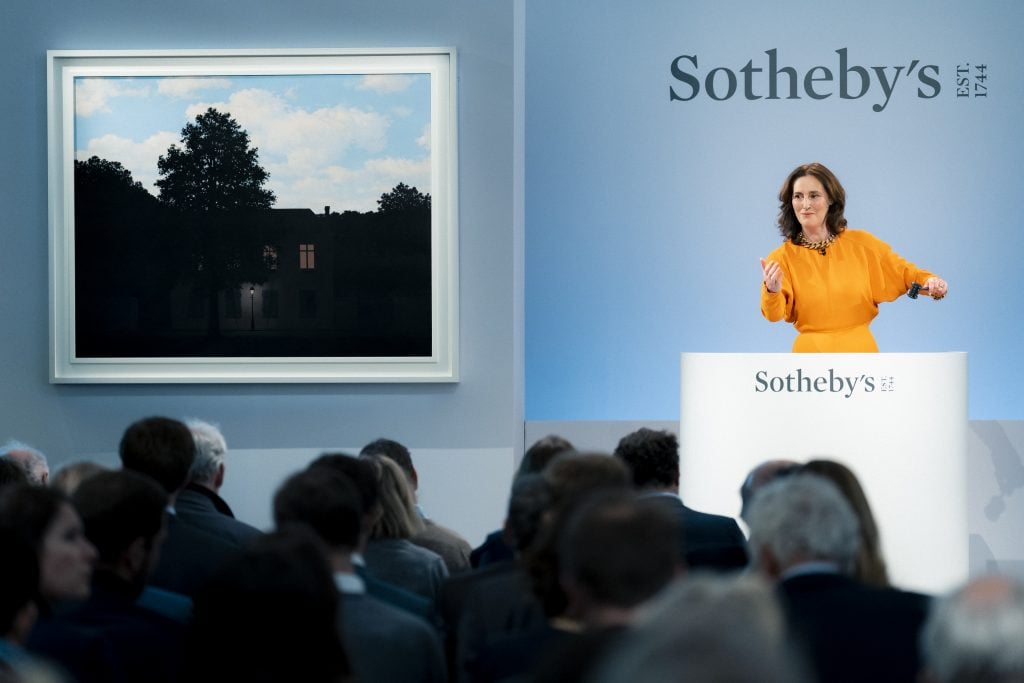
Sotheby’s Helena Newman with René Magritte, L’empire des lumières (1961). Courtesy Sotheby’s
Meanwhile, sales at public auction of fine and decorative art and antiques reached an estimated $26.3 billion in 2021, an increase of 47 percent on 2020. This was driven by the supply of high-quality works coming onto the market, as well as an influx of new buyers.
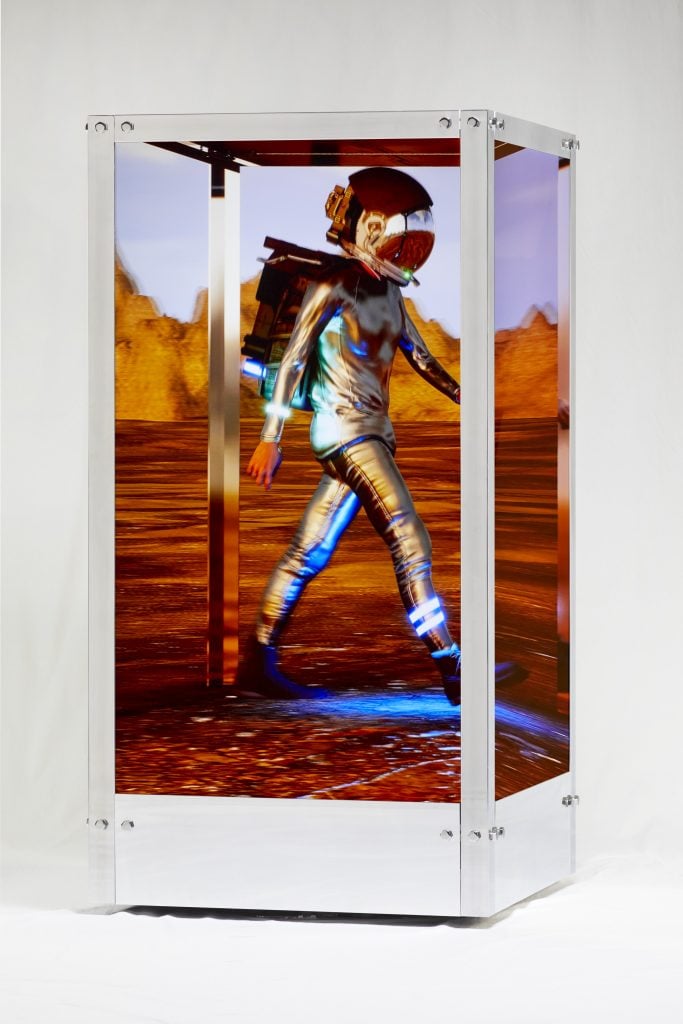
Beeple, HUMAN ONE(2021), sold for $29 million (est. $15 million) at Christie’s November 2021 “21st century art” evening sale in New York. Courtesy Christie’s.
In addition to the global art market’s turnover of $65.1 billion, sales of NFTs boomed on NFT platforms. The value of sales for art-related NFTs taking place outside of the art market expanded over one-hundred-fold in 2021 year-on-year, reaching $2.6 billion, with even greater growth in collectibles, which hit $8.6 billion.
The volume of transactions on these external NFT platforms also expanded rapidly, growing from just over 755,760 in 2019 to 5.5 million, with collectibles heavily dominating sales (85 percent of transactions in 2021). In 2021, 74 percent of HNW collectors surveyed by Arts Economics and UBS Investor Watch had purchased art-based NFTs, with a median expenditure in the category totaling $9,000 each.
NFT sales also entered the traditional art market’s auction sector in 2021. Christie’s NFT sales totaled $150 million, including the landmark sale of Beeple’s Everydays: The First 5000 Days (2021) for $69.3 million in March. Sotheby’s NFT sales, meanwhile, reached $80 million in 2021.
The digital art boom was also the most successful avenue in attracting young and new buyers, with 78 percent of NFT bidders being new to Sotheby’s and more than half of them under 40.
The online market continued to expand, growing by a more moderate seven percent in 2021 and reaching an estimated $13.3 billion. The share accounted for by online sales in 2021 was 20 percent of total sales, down five percent year-on-year but still more than double the level of 2019, which was 19 percent.
Art Basel global director Marc Spiegler commented: “As expected, the share of online art sales dropped in 2021 as in-person sales rebounded—but the total value of online sales grew again. Clearly, artworld e-commerce is here to stay.”
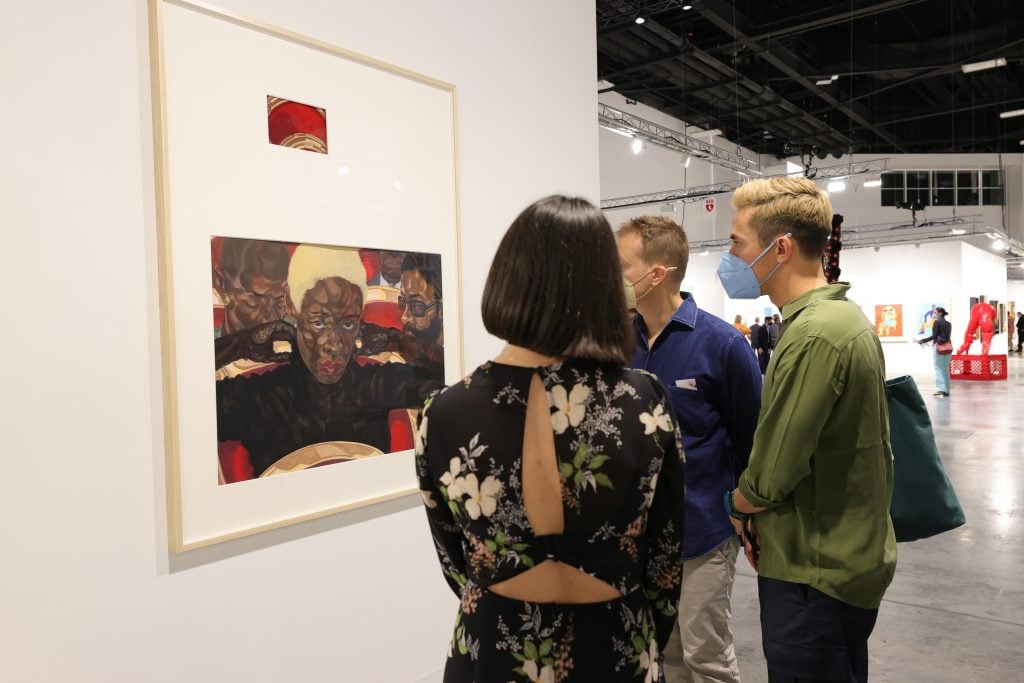
Visitors at Jack Shainman’s booth in Miami Beach, Florida. (Photo by Cindy Ord/Getty Images)
In 2021, as the fair calendar resumed, even with a reduced number of fairs and limited capacity in some, art fair sales advanced to account for 29 percent of gallery sales (that includes sales in online viewing rooms), up seven percent in share year-on-year—but still nowhere close to the 43 percent of dealer sales reported in 2019. With the slow return to the full schedule of events and continuing focus on cost, the number of art fairs at which dealers exhibited in 2021 was still below pre-pandemic levels.
However, looking ahead, the majority of dealers surveyed (65 percent) predicted their art fair sales would increase over the next 12 months, 11 percent were unsure, and only nine percent expected a decline. This last data point may come as a surprise given the number of dealers who said they would pull back on art fairs after sales remained strong without physical participation during the lockdown period. However, it might reflect a renewed demand and interest in IRL events for dealers as the art world continues to emerge from the pandemic.
Based on surveys of more than 2,300 HNW collectors across ten markets, the UBS Art Basel Report found an increase in spending at high levels in 2021. Collectors reported having purchased more art and antiques in 2021 on average than they did in either 2019 or 2020.
Looking ahead to the next 12 months, the majority of HNW collectors (53 percent) said they were planning to buy art in 2022. A growing interest in digital art is evident as well, particularly among younger collectors, as over half of the HNW collectors surveyed (56 percent) reported that they were interested in buying digital art this year, the highest percentage being among millennial collectors (61 percent).